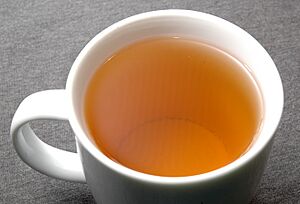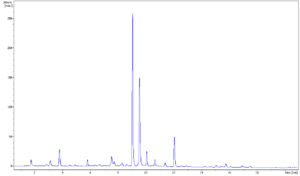Phenolic content in tea facts for kids
The phenolic content in tea refers to natural plant compounds called phenols and polyphenols found in tea. These special chemical compounds are important because they affect how tea tastes and feels in your mouth. Some of the main polyphenols in tea include catechins, theaflavins, tannins, and flavonoids.
For example, green tea has many polyphenols, including epigallocatechin gallate (EGCG), epigallocatechin, epicatechin gallate, and epicatechin. Other types of plant compounds called flavanols like kaempferol, quercetin, and myricitin are also found in green tea.
Contents
Catechins: Tea's Building Blocks
Catechins are a very important group of polyphenols found in tea. They include compounds like epigallocatechin-3-gallate (EGCG), epicatechin (EC), and epigallocatechin (EGC). Green tea is especially rich in EGCG.
These catechins make up about a quarter of the dry weight of a fresh tea leaf! The exact amount can change depending on the type of tea plant, where it grows, the season, how much sunlight it gets, and even the altitude. You can find catechins in almost all teas made from the Camellia sinensis plant, including white tea, green tea, black tea, and oolong tea.
Theaflavins: Giving Black Tea Its Color

When tea leaves are processed, especially to make black tea, the catechins change into new compounds called theaflavins. These theaflavins are what give black tea its special color, from bright orange to reddish-brown. They also add to the slightly bitter and refreshing taste of black tea.
There are a few main types of theaflavins found in black tea. These compounds are formed as the tea leaves are exposed to air and go through a process called oxidation.
Tannins: The Astringent Taste
Tannins are another group of polyphenols in tea. They are known for making your mouth feel dry or puckery, a sensation called "astringency." This is because tannins can bind to and affect other compounds.
For example, some catechins, like EGCG, are also considered tannins because they have these astringent qualities. This is why a strong cup of tea can sometimes make your mouth feel a bit dry.
Flavonoids: Common Plant Compounds
Flavonoids are a large group of phenols found in many plants, including tea. Tea is actually one of the foods and drinks with the highest amount of flavonoids!
While scientists are still studying flavonoids, there isn't clear evidence yet that they have special health benefits in the human body or can prevent diseases. However, they are a big part of what makes tea a complex and interesting drink. In growing tea leaves, catechins are the most common type of flavonoids.
For example, a typical cup of green tea (about 200 ml) has around 266 milligrams of flavonoids, and a cup of black tea has about 233 milligrams.
Research: Tea and Your Heart
Scientists are always studying the effects of tea. A review of studies in 2020 suggested that drinking tea every day might help lower the risk of cardiovascular disease (heart and blood vessel problems) and related deaths. This research is ongoing, but it's an interesting area of study for tea lovers!


